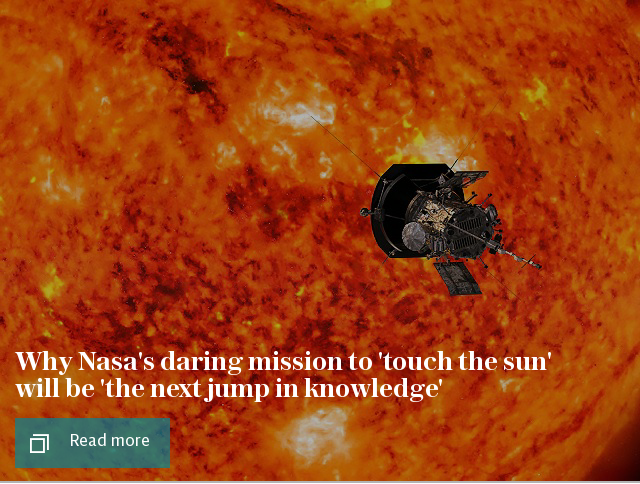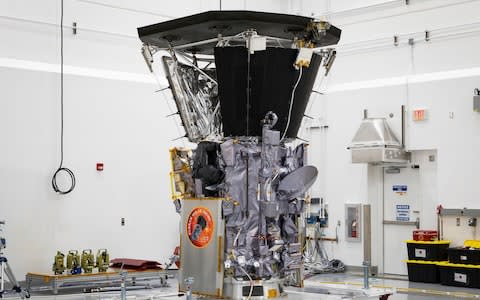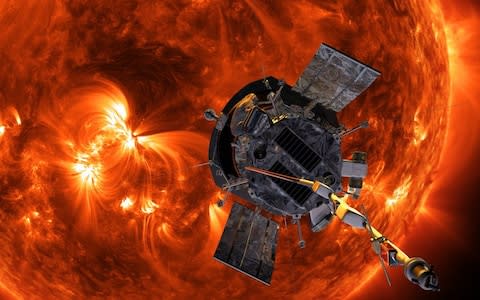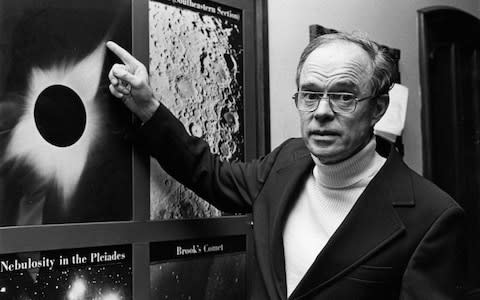Nasa probe will still be circling Sun at end of Solar System, say scientists

Nasa's new solar spacecraft is so indestructable that parts of it will be circling the Sun until the Solar System ends, eight billion years from now, scientists have said.
The US space agency launches its Parker Solar Probe on Saturday, which will travel closer to the Sun than any mission before, to unlock the secrets of fierce radioactive storms which threaten Earth.
Earth, and all the other objects in the Solar System are constantly ploughing through what is known as the solar wind - a constant stream of high-energy particles, mostly protons and electrons, hurled into space by the Sun.
These radioactive storms are so powerful they are able to knock out satellites, disrupt services such as communications and GPS, threaten aircraft and even interfere with electricity supplies.
The mission is to reach Sun’s outer atmosphere, or corona, the closest any man-made instrument has ever got to a star. For seven years it will orbit at around 3.38 million miles from the star's surface, where temperatures reach 1,400C.

The probe is relying on a 4.5 inch carbon heat shield which has taken 10 years to develop and which is so strong it will survive for billions of years even when the rest of the spacecraft has disintegrated.
Speaking at a briefing ahead of the launch, Andy Driesman, Parker Solar Probe Programme Manager from Johns Hopkins University, said: "At four million miles the Sun is very hot, so we need to bring an umbrella with us.
"It’s a carbon heat shield. It took 18 months to fabricate it and a decade to develop it.
"Eventually the spacecraft will run out of propellant and will leave altitude control and parts of it will transition into the Sun. But hopefully in 10 to 20 years there is going to be this carbon disc and that will be around to the end of the Solar System."

The spacecraft also holds a memory card containing the names of more than 1.1 million members of the public who were asked to write in to support the mission.
London-born professor Nicky Fox, project scientist from Johns Hopkins University, said: "I think the spacecraft will break up into parts and form dust, and then those names will orbit the Sun forever."
The nearest a spacecraft has previously come to the Sun was the Helios 2 mission in 1976, which flew to within 27 million miles.

Once inside the corona, sensory equipment will attempt to ‘taste’ and ‘smell’ electronic particles while they are still moving slowly enough to be measured.
Professor Mathew Owens, space scientist at the University of Reading, said: “It's an incredibly hostile environment in which to do science, so the spacecraft has faced enormous engineering challenges. But everything is looking positive for Saturday.
“The thing we really don't understand about the Sun, and therefore stars in general, is why its atmosphere gets hotter further away from the heat source.
“We've been trying to solve this mystery for more than 50 years, by taking measurements from a nice, safe distance, and it's left us in an unusual position. We've got a bunch of theories that seem to work, but don't know which ones actually explain the Sun.”
Currently, solar activity is monitored by a network of satellites, but scientists still have a poor understanding of how radiation builds up in the star’s outer atmosphere and then accelerates towards Earth.
A better understanding of “space weather” is also considered crucial for protecting astronauts and their equipment for any future endeavours to colonise the Moon or Mars.
The Parker Solar Probe, which weights 1,400lbs, will travel faster than any craft ever before at 430,000 mph, and during its seven-year mission will make 24 orbits of the Sun.
The spacecraft will carry instruments to measure bulk plasma, described as the 'bread and butter' of solar waves, as well as a full package of magnetic measuring equipment.

It will also carry a white light imager, dubbed 'Whisper', which can photograph solar waves.
“Where does the solar wind come from? What causes flares and coronal mass ejections? We still don’t understand these processes,” said Justin Kasper, professor of climate and space sciences and engineering at the University of Michigan, mission principal investigator on the Parker Solar Probe.
“The Parker Solar Probe will help us do a much better job of predicting when a disturbance in the solar wind could hit Earth.”
The mission was named after Eugene Parker, the solar astrophysicist who first discovered the solar wind, and has been in the works for more than half a century. The memory card on board also contains a copy of his first scientific paper outlining his work.
It was conceived before a space programme, or even Nasa, existed.

